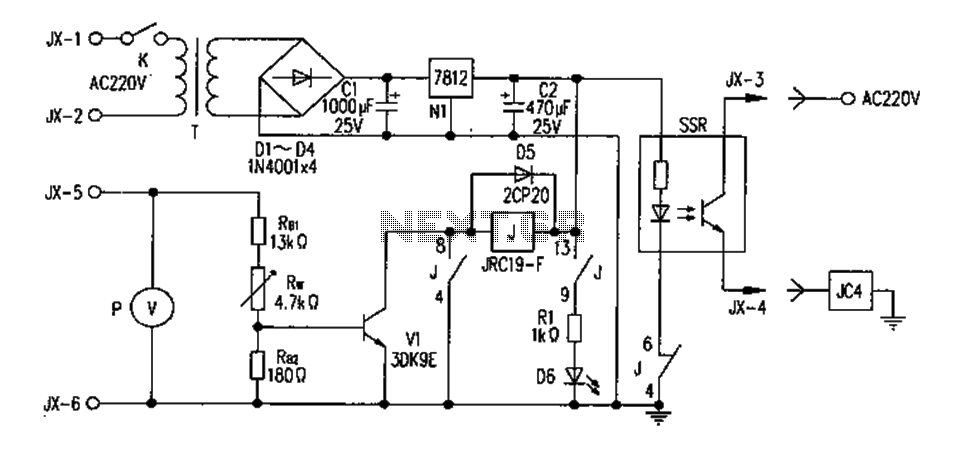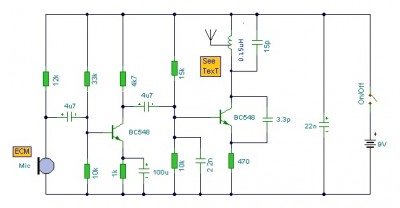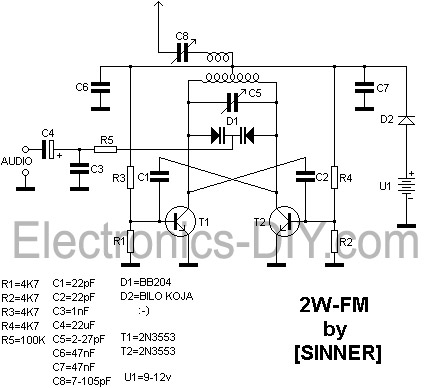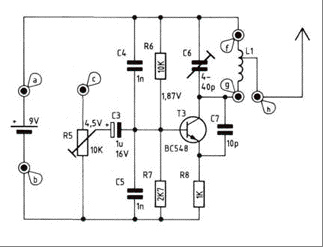
serial ir transmitter
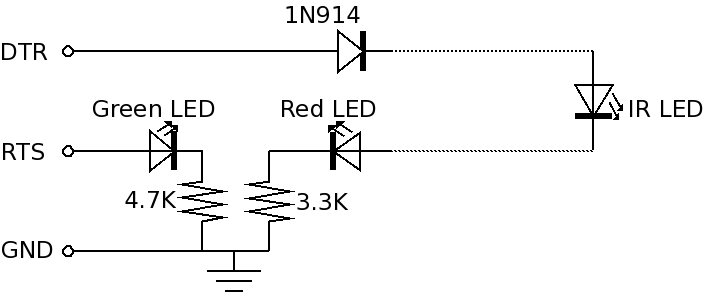
This circuit is a basic design that includes indicator LEDs and appropriate resistor values. A dotted line indicates that the IR LED is connected to the circuit via a length of wire (in this case, a telephone cable). The Linux infrared daemon, lircd, activates the RTS (ready-to-send) serial line to a positive voltage of approximately +12V as part of its initialization process. This voltage is used to illuminate a green LED, signaling that the driver is loaded and that the basic connections are functioning correctly. Lircd transmits infrared signals as a series of 38 kHz pulses on the DTR (data-terminal-ready) line, which can be detected by devices equipped with IR receivers. The red LED is visible to the human eye, providing a visual indication of activity. This low-power IR transmitter is designed to be positioned close to the receiver box (within 1-2 feet). It has proven to be reliable within this range, with both LEDs being visible, and the red flash LED effectively attracting attention. Understanding Ohm's law is crucial for comprehending the operation of this circuit. Key points include that the positive RTS and DTR voltage measures approximately +11.5V on the testing machine, and it is advisable not to draw more than 10-12 mA from the serial chip. Applying Ohm's law to the green LED is essential, as RTS and DTR voltages could potentially be negative, which could damage the LEDs. A 1N914 (or 1N4148) diode is included for protection. Although an additional diode for the green LED is not deemed necessary with the specific hardware used, it is still a good practice. The 1N914 is the component number from Radio Shack, and alternatives such as the 1N4148 can also be utilized. The green and red LEDs are sourced from a Radio Shack variety pack, while the IR LED was salvaged from an old remote control. The circuit incorporates a 4.7kΩ resistor, identifiable by its yellow-violet-red color code, and a 3.3kΩ resistor, identifiable by its orange-orange-red color code.
This circuit serves as a fundamental example of a low-power infrared transmitter, leveraging basic electronic components to achieve effective communication with infrared receivers. The design's simplicity allows for easy assembly and troubleshooting, making it suitable for beginners in electronics. The inclusion of indicator LEDs enhances the user interface by providing visual feedback on the circuit's operational status.
The choice of components, such as the 1N914 or 1N4148 diodes, serves to protect sensitive parts of the circuit from potential voltage spikes or incorrect polarity, ensuring longevity and reliability. The use of standard resistor values, along with the application of Ohm's law, facilitates the calculation of current flow through the LEDs, ensuring they operate within safe limits.
The physical layout of the circuit, with the IR LED connected via a telephone cable, allows for flexibility in positioning the transmitter relative to its receiver. This configuration is particularly useful in applications where space constraints exist or where the transmitter needs to be discreetly placed.
Overall, this circuit exemplifies fundamental principles of electronics while providing practical functionality in infrared communication, making it an excellent project for those seeking to enhance their understanding of electronic circuits and components.This is essentially the simplest circuit with additional indicator LED`s and appropriate resistor values. The dotted line is to indicate that the IR LED is separated by a length of wire (telephone cable in this case) from the rest of the circuit.
The linux infra-red daemon lircd pulls the RTS (ready-to-send) serial line positive (about +12V) as pa rt of its initialization. This circuit uses that to light a green LED indicating that the driver is loaded and basic connections are at least superficially in order. Lircd transmits IR signals as a series of 38Khz pulses on the DTR (data-terminal-ready) line. Equipment with IR receivers will pick-up the pulses from the IR LED. Humans can see the pulses from the red LED. This is a low power IR transmitter intended to be attached to the front of or very near (1-2 ft. ) the receiver box. I`ve found it very reliable in this range. Both LED`s are visible and the red flash LED easily catches the eye. If you know nothing else about electronics theory you should at least learn Ohm`s law. It easily determines the entire operation of this circuit. Note the following points: I measure the positive RTS and DTR voltage at about +11. 5V on my machine. It`s not recommended that you draw more than say 10-12mA from the serial chip. Using these values and applying Ohm`s law to the green LED: RTS and DTR may also be negative and -12Volts would likely damage the LED`s.
The 1N914 (or 1N4148) diode protects them. There should also be a diode protecting the green LED but I`ve not found this necessary with my specific hardware. 1N914 is the radio shack component number for the diode. Anything reasonable would work here and other circuits suggest 1N4148. The green and red LED`s are smaller ones from a radio shack variety pack and the IR LED was removed from an old remote control.
The 4. 7k © resistor is colored yellow/violet/red and the 3. 3k © orange/orange/red. See 🔗 External reference
This circuit serves as a fundamental example of a low-power infrared transmitter, leveraging basic electronic components to achieve effective communication with infrared receivers. The design's simplicity allows for easy assembly and troubleshooting, making it suitable for beginners in electronics. The inclusion of indicator LEDs enhances the user interface by providing visual feedback on the circuit's operational status.
The choice of components, such as the 1N914 or 1N4148 diodes, serves to protect sensitive parts of the circuit from potential voltage spikes or incorrect polarity, ensuring longevity and reliability. The use of standard resistor values, along with the application of Ohm's law, facilitates the calculation of current flow through the LEDs, ensuring they operate within safe limits.
The physical layout of the circuit, with the IR LED connected via a telephone cable, allows for flexibility in positioning the transmitter relative to its receiver. This configuration is particularly useful in applications where space constraints exist or where the transmitter needs to be discreetly placed.
Overall, this circuit exemplifies fundamental principles of electronics while providing practical functionality in infrared communication, making it an excellent project for those seeking to enhance their understanding of electronic circuits and components.This is essentially the simplest circuit with additional indicator LED`s and appropriate resistor values. The dotted line is to indicate that the IR LED is separated by a length of wire (telephone cable in this case) from the rest of the circuit.
The linux infra-red daemon lircd pulls the RTS (ready-to-send) serial line positive (about +12V) as pa rt of its initialization. This circuit uses that to light a green LED indicating that the driver is loaded and basic connections are at least superficially in order. Lircd transmits IR signals as a series of 38Khz pulses on the DTR (data-terminal-ready) line. Equipment with IR receivers will pick-up the pulses from the IR LED. Humans can see the pulses from the red LED. This is a low power IR transmitter intended to be attached to the front of or very near (1-2 ft. ) the receiver box. I`ve found it very reliable in this range. Both LED`s are visible and the red flash LED easily catches the eye. If you know nothing else about electronics theory you should at least learn Ohm`s law. It easily determines the entire operation of this circuit. Note the following points: I measure the positive RTS and DTR voltage at about +11. 5V on my machine. It`s not recommended that you draw more than say 10-12mA from the serial chip. Using these values and applying Ohm`s law to the green LED: RTS and DTR may also be negative and -12Volts would likely damage the LED`s.
The 1N914 (or 1N4148) diode protects them. There should also be a diode protecting the green LED but I`ve not found this necessary with my specific hardware. 1N914 is the radio shack component number for the diode. Anything reasonable would work here and other circuits suggest 1N4148. The green and red LED`s are smaller ones from a radio shack variety pack and the IR LED was removed from an old remote control.
The 4. 7k © resistor is colored yellow/violet/red and the 3. 3k © orange/orange/red. See 🔗 External reference
